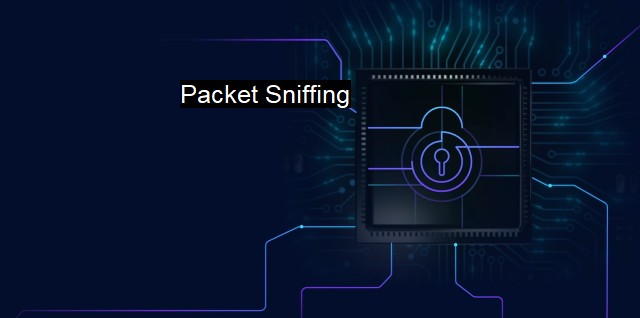What is Packet Sniffing?
Unveiling Cybersecurity Threats with Packet Sniffing: Analyzing Network Traffic to Protect Organizations and Users from Malicious Attacks
Packet sniffing, from a cybersecurity perspective, describes the technique of capturing, inspecting, and/or interpreting data packets circulating within networks. It's a method commonly used to pinpoint, analyze, diagnose, and respond to network issues such as outages, bottlenecks, or possible security breaches. Although packet sniffing has legitimate applications in network management and diagnostics, it is often associated with malignant computer activities.A data packet, to provide context, is the information unit transmitted across digital networks. Each packet, analogous to a digital courier, consists of a payload—the actual data sought to be communicated—and the header that carries routing specifications for the packet’s journey and other information vital for packet management.
Technically, packet sniffing is comparable to wiretapping on a digital scale. Computers continuously receive and send information over a network, with each data packet like an open letter, fully readable. A packet sniffer works by tapping into this flow, isolating, and analyzing the inbound and outbound data, giving a comprehensive view of the network's activity.
Packet sniffing isn't only beneficial for diagnosing network issues or monitoring for performance; it presents a substantial security concern. Being that packet sniffers can see all data transit through a network, unauthorized or malignant deployment of a packet sniffer in a network potentially opens up a broad map of users' activities.
Hackers particularly take advantage of packet sniffing for various malevolent purposes. For instance, they can use sniffers to collect sensitive data such as login credentials, financial data, personal messages, or any unprotected information from unprotected networks. Such illegal sniffing is called “passive sniffing” as the hackers blend in without altering the data packets. It's a widely used method in cybersecurity attacks, rightfully causing concerns with cybersecurity personnel, corporations, and individuals alike.
On the flip side, packet sniffing is often used in ethical hacking, cybersecurity measures, or antivirus software to locate vulnerabilities, monitor traffic, prevent breaches, or repair network infrastructures. Ethical hackers, cybersecurity professionals, employ packet sniffing tools to understand attack vectors, identify vulnerabilities, and mend them before malevolent hackers exploit them.
Part of this includes antivirus companies, which loop in packet sniffing as part of their cybersecurity arsenal. An antivirus program that includes a packet sniffing feature can actively monitor network traffic for suspicious activities or malware communication—that is, malicious servers or software regularly sending and receiving information. When such traffic is flagged, the antivirus informs the user or takes pre-set actions, which might include blocking the suspicious data packets or restricting the responsible software.
Packet sniffing can ensure effective internal security controls. Businesses can ensure compliance and regulations with sniffing by monitoring employee activities. This visibility helps prevent internal threats, illicit data handling practices, or non-compliant cybersecurity behavior. Yet, it's critical to balance this against privacy regulations and rights.
Packet sniffing is crucial in the cybersecurity landscape. It's a simultaneously powerful and potentially destructive tool demanding sound practices and procedures. By understanding the capabilities and potential threats of packet sniffing, security teams can better protect their networks, ensure compliance, and respond more effectively to breaches.
It underscores how essential data security is for both organizations and individuals. Given the increasing sophistication and frequency of cyber-attacks, users must ensure data encryption, safe connections, updated antivirus software, and other appropriate cybersecurity measures to safeguard their sensitive data from exploitation. And more than anything, awareness and proper education about cybersecurity and nuances like packet sniffing are most important. They promote responsible online behavior and foster an atmosphere of cybersecurity hygiene among internet users.

Packet Sniffing FAQs
What is packet sniffing?
Packet sniffing is the practice of intercepting and examining data packets that are transmitted over a network. It is a common technique used in cybersecurity to monitor network traffic and identify potential security threats.Is packet sniffing legal?
Packet sniffing can be legal or illegal, depending on the context in which it is used. In most cases, packet sniffing is legal when it is used for legitimate purposes, such as network troubleshooting or security monitoring. However, it can be illegal if it is used to intercept personal or confidential information without proper authorization.How can I protect myself from packet sniffing?
To protect yourself from packet sniffing, you should use encryption and secure protocols whenever possible. This can include using HTTPS instead of HTTP, using VPNs to encrypt your internet traffic, and ensuring that your wireless network is secured with a strong password. You should also avoid using public Wi-Fi networks, as these are often unsecured and can be easily intercepted by packet sniffers.Can antivirus software detect packet sniffers?
Some antivirus software programs can detect and block packet sniffing tools and other types of malware that may be used to intercept network traffic. However, antivirus software is not always effective at detecting and blocking all types of packet sniffers, especially those that are designed to evade detection. To maximize your protection against packet sniffing, it is recommended that you use a combination of antivirus software, firewalls, and other security tools.| | A | | | B | | | C | | | D | | | E | | | F | | | G | | | H | | | I | | | J | | | K | | | L | | | M | |
| | N | | | O | | | P | | | Q | | | R | | | S | | | T | | | U | | | V | | | W | | | X | | | Y | | | Z | |
| | 1 | | | 2 | | | 3 | | | 4 | | | 7 | | | 8 | | |||||||